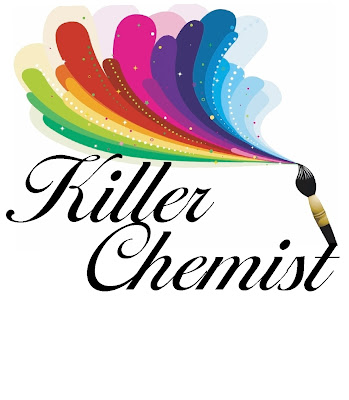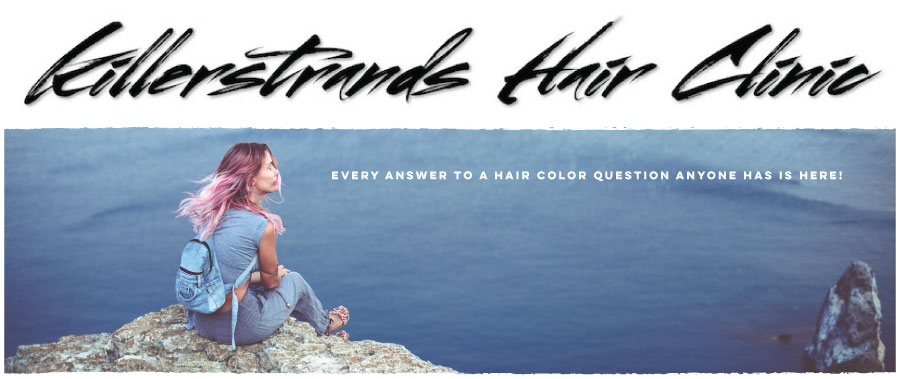It is NOT completely easy to understand how the hair coloring process takes place, but I promise you if I can learn to grasp it.....then certainly YOU can !
You just have to promise me you will read this post more than once. You know how I know you can grasp it? I went to Hair Academy when I was 40 years old. I was the oldest one in the whole Academy .....older than every teacher.......older the administration and older than the Director....I had already raised my kids and experienced a 15 year career as a Stunt Woman in Hollywood. I even have a Stunt Award - which is our equivalent to a Academy Award, when I won mine they were televised, but no more.
I knew ZERO about hair. Absolutely frickin' nothing - and- I finally understood it.
How?
By reading and re-reading my notes from school. The repetition is the key. It WILL sink in and make sense.
That is what I want you to do until you understand it, that is what they taught me and damn it, they were right.
Oxidative Hair Coloring -
That is what almost every hair color that we use today is called, this post is extremely important for you to understand how hair color works, no its not easy to understand but please come back to this post every now and then so you can read and review it.
Oxidation:
1.The reaction of dye intermediates found in
hair coloring developers with hydrogen peroxide 2. The interaction of hydrogen peroxide on the natural pigment.
Deposit:
describes the color product in terms of its ability to add color pigment to the hair. Color added equals DEPOSIT.
Lift: The lightening action of a hair color or lightening product on the hair's natural pigment
 Hydrogen Peroxide:
Hydrogen Peroxide:
An Oxidizing chemical made up of 2 parts hydrogen & 2 parts oxygen (H2O2) used to aid the processing of permanent hair color and lighteners. Also referred to as a developer by Stylists/Colorists; available in liquid or cream.
Now we move to the Hydrogen Peroxide the "white creme" in the other bottle! There is also violet as you see above which is used in fighting brass in Blondes! Killerstrands little store is the only online store selling it so please click on the photo to a direct link.
Within the BOXED KITS OF COLOR (I'm on the war path against) there are 2 items enclosed, one is a bottle of color the other a bottle of peroxide.

Blonding:
The percentage of Lift in any color is directly related to its AMMONIA content. At times you will hear Color lines boasting of "no ammonia" which only means they are using ANOTHER chemical to do the same exact thing - (it baffles me why people think : 'that's better').
There are a couple similar ingredients but - mostly they use MEA). Or, it is a brown or blackish type color and there is no "lifting" needed. For example: in many men's color lines promising to cover grey and not change anything else. There is nothing wrong with ammonia - people panic unnecessarily over the name, is my feeling. The true only disadvantage to ammonia in hair color: is - - if - - you are allergic to it, which is rare, but does happen, ammonia does work best for light blonding and lifting.
Oxidation
The percentage of dye content in the bottle is also known as pigment weight. The more dye molecules in the bottle, the more depositing capabilities the color has. The action of depositing dye or color molecules into the cortex of the hair shaft is partly triggered by OXIDATION, which is achieved by adding hydrogen peroxide (H2O2) to the color.
You see..........this is why Developer is absolutely necessary to the hair coloring process.
Once the hydrogen peroxide is completely oxidized, it turns into water (H2O), and its chemical action stops. The color molecules return to their original structure and become part of the structure of the cortex. The cuticle closes, trapping the dye or color molecules inside..........now, the color process is complete.
Don't let me lose you here, this may seem boring/confusing>or BOTH!! but... it will all make sense as you read and re-read it.
If it doesn't, then ask me questions LOTS of them, I want you to get it...I truly do, because if you do... then you will have knowledge that some of the top Colorists in the country possess & that is what ROCKS about teaching.

You just have to promise me you will read this post more than once. You know how I know you can grasp it? I went to Hair Academy when I was 40 years old. I was the oldest one in the whole Academy .....older than every teacher.......older the administration and older than the Director....I had already raised my kids and experienced a 15 year career as a Stunt Woman in Hollywood. I even have a Stunt Award - which is our equivalent to a Academy Award, when I won mine they were televised, but no more.
I knew ZERO about hair. Absolutely frickin' nothing - and- I finally understood it.
How?
By reading and re-reading my notes from school. The repetition is the key. It WILL sink in and make sense.
That is what I want you to do until you understand it, that is what they taught me and damn it, they were right.
Oxidative Hair Coloring -
That is what almost every hair color that we use today is called, this post is extremely important for you to understand how hair color works, no its not easy to understand but please come back to this post every now and then so you can read and review it.
Oxidation:
1.The reaction of dye intermediates found in
hair coloring developers with hydrogen peroxide 2. The interaction of hydrogen peroxide on the natural pigment.
Deposit:
describes the color product in terms of its ability to add color pigment to the hair. Color added equals DEPOSIT.
Lift: The lightening action of a hair color or lightening product on the hair's natural pigment
 Hydrogen Peroxide:
Hydrogen Peroxide:An Oxidizing chemical made up of 2 parts hydrogen & 2 parts oxygen (H2O2) used to aid the processing of permanent hair color and lighteners. Also referred to as a developer by Stylists/Colorists; available in liquid or cream.
Now we move to the Hydrogen Peroxide the "white creme" in the other bottle! There is also violet as you see above which is used in fighting brass in Blondes! Killerstrands little store is the only online store selling it so please click on the photo to a direct link.
Within the BOXED KITS OF COLOR (I'm on the war path against) there are 2 items enclosed, one is a bottle of color the other a bottle of peroxide.

Blonding:
The percentage of Lift in any color is directly related to its AMMONIA content. At times you will hear Color lines boasting of "no ammonia" which only means they are using ANOTHER chemical to do the same exact thing - (it baffles me why people think : 'that's better').
There are a couple similar ingredients but - mostly they use MEA). Or, it is a brown or blackish type color and there is no "lifting" needed. For example: in many men's color lines promising to cover grey and not change anything else. There is nothing wrong with ammonia - people panic unnecessarily over the name, is my feeling. The true only disadvantage to ammonia in hair color: is - - if - - you are allergic to it, which is rare, but does happen, ammonia does work best for light blonding and lifting.
Oxidation
The percentage of dye content in the bottle is also known as pigment weight. The more dye molecules in the bottle, the more depositing capabilities the color has. The action of depositing dye or color molecules into the cortex of the hair shaft is partly triggered by OXIDATION, which is achieved by adding hydrogen peroxide (H2O2) to the color.
You see..........this is why Developer is absolutely necessary to the hair coloring process.
The KEY to How the Whole Action
of Hair Coloring Takes Place:
- The dye molecule in any permanent color is too large to penetrate the cuticle of the hair shaft without first altering its structure with hydrogen peroxide.
- Since without hydrogen peroxide the dye will only stain the cuticle layer, understanding what happens when you add hydrogen peroxide to color is essential.
- That is also where the difference between Permanent,Semi-permanent, and Temporary color rests.
Once the hydrogen peroxide is completely oxidized, it turns into water (H2O), and its chemical action stops. The color molecules return to their original structure and become part of the structure of the cortex. The cuticle closes, trapping the dye or color molecules inside..........now, the color process is complete.
Don't let me lose you here, this may seem boring/confusing>or BOTH!! but... it will all make sense as you read and re-read it.
If it doesn't, then ask me questions LOTS of them, I want you to get it...I truly do, because if you do... then you will have knowledge that some of the top Colorists in the country possess & that is what ROCKS about teaching.





















Be First to Post Comment !
Post a Comment
All comments are moderated. Please do not include: references to personal information, or any profane, inflammatory or copyrighted comments. We would appreciate it if we all stick to the subject of HAIR . Have a wonderful day.